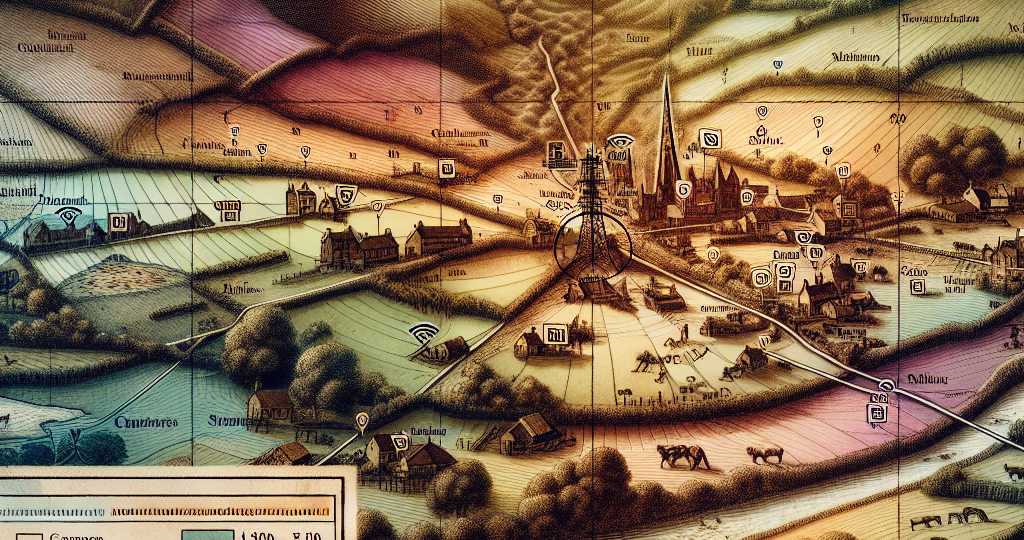Exploring Rural Internet Coverage: Where Does Your Area Stand on the Map?
September 12, 2024 | by Jerry Rodriguez

In today’s digital age, internet access has become a necessity for communication, work, and education. However, many rural areas still struggle with inadequate coverage. The rural internet coverage map serves as a resource to identify the availability and quality of internet services in remote regions. This map highlights the disparities in connectivity between urban and rural areas, shedding light on the digital divide that exists in our society. By exploring this map, individuals can assess the status of internet coverage in their area and advocate for improved access. Join us on a journey to uncover the reality of rural internet coverage and bridge the gap between digital haves and have-nots.
In my area, the rural internet coverage is limited. Many residents have to rely on satellite internet or mobile hotspots, which can be unreliable and slow. There are ongoing efforts to expand broadband access, but progress has been slow. Overall, my area is still behind in terms of internet coverage compared to more urban areas.
Understanding Rural Internet Access

Challenges faced by rural communities
- Geographical barriers: Rural areas often have rugged terrains and remote locations, making it challenging for internet service providers to establish infrastructure.
- Lack of population density: With fewer residents in rural areas, the return on investment for internet providers may be lower, leading to limited coverage.
- High costs: Building and maintaining internet infrastructure in rural areas can be expensive, especially when considering the vast distances that need to be covered.
- Limited competition: In many rural areas, there may be only one or two internet service providers available, reducing options for residents and potentially leading to higher prices.
- Technological limitations: Some rural areas may lack access to the latest technological advancements in internet connectivity, such as fiber-optic networks, due to the costs involved in upgrading infrastructure.
Importance of reliable internet in rural areas
- Economic development: Reliable internet access is crucial for rural economies to thrive, allowing businesses to connect with customers globally and access online markets.
- Education opportunities: With the increasing reliance on online learning platforms, students in rural areas need reliable internet access to access educational resources and participate in virtual classrooms.
- Telemedicine: In remote rural areas, access to telemedicine services can be a lifeline for residents who may not have easy access to healthcare facilities, highlighting the importance of reliable internet connectivity.
- Quality of life: Internet access in rural areas enables residents to stay connected with loved ones, access entertainment, and engage in online services that enhance their overall quality of life.
Factors Affecting Rural Internet Coverage
- Distance from Telecommunication Infrastructure
In rural areas, the distance from existing telecommunication infrastructure plays a crucial role in determining the quality and availability of internet coverage. Remote locations far from network hubs or fiber optic cables may experience slower internet speeds or even complete lack of connectivity. The cost of extending these infrastructures to rural areas can be prohibitive, further exacerbating the issue.
- Topography and Terrain
The geographical features of rural areas, such as mountains, valleys, or dense forests, can significantly impact internet coverage. These natural barriers can obstruct wireless signals and make it challenging to establish reliable connections. In areas where signals are weakened or disrupted by the landscape, residents may struggle to access high-speed internet services.
- Population Density
Population density in rural areas is generally lower compared to urban areas, making it less economically viable for internet service providers to invest in expanding coverage. With fewer potential customers spread out over larger areas, providers may prioritize urban and suburban regions where the return on investment is higher. This disparity in coverage can leave rural communities underserved in terms of internet access.
The Role of Internet Service Providers (ISPs)
Understanding Rural Internet Access
Internet Service Providers (ISPs) play a crucial role in determining the level of internet coverage in rural areas. Several factors contribute to the disparities in service provision across different regions:
- Infrastructure Investment: ISPs often prioritize urban areas for infrastructure development due to higher population density and potential profitability. This leaves rural areas with limited access to high-speed internet services.
- Regulatory Environment: The regulatory framework can influence ISPs’ willingness to expand coverage in rural areas. Complex regulations or lack of incentives for companies to invest in underserved regions can further exacerbate the digital divide.
- Technological Limitations: The cost of deploying internet infrastructure in remote areas with challenging terrain or low population density can be prohibitively high for ISPs. This leads to slower or unreliable internet connections for rural residents.
- Market Competition: In areas where multiple ISPs operate, competition can drive expanded coverage as companies vie for customers. However, in many rural regions, limited competition results in a lack of incentive for ISPs to improve services or expand their networks.
- Government Initiatives: Some governments provide subsidies or grants to encourage ISPs to extend coverage to underserved areas. These initiatives can help bridge the gap in rural internet access but may not always be sufficient to address the full extent of the problem.

Mapping Rural Internet Coverage
In the realm of rural internet coverage, mapping plays a crucial role in understanding the digital landscape. By delving into the specifics of how different regions are serviced, individuals and communities can gain valuable insights into their connectivity options.
Overview of rural internet coverage maps
- Purpose: These maps are designed to showcase the extent of internet coverage in rural areas, highlighting the presence or absence of high-speed internet access.
- Data Sources: The information presented on these maps is sourced from various entities, such as internet service providers, governmental agencies, and independent research organizations.
- Representation: Rural internet coverage maps typically utilize color coding or shading to differentiate between areas with varying levels of connectivity. This visual representation allows users to quickly identify internet deserts or areas with robust coverage.
How to access and interpret these maps
- Accessibility: Many rural internet coverage maps are available online and can be accessed through websites of organizations specializing in broadband research or government portals dedicated to digital infrastructure.
- Interpretation: Understanding these maps involves analyzing key indicators such as internet speeds, availability of different types of internet technologies (e.g., DSL, cable, fiber), and the presence of underserved or unserved areas.
- Utilization: Individuals and policymakers can leverage these maps to advocate for improved internet access, make informed decisions about selecting internet service providers, and prioritize areas for infrastructure development initiatives.
Identifying Coverage Gaps
Mapping Rural Internet Coverage
In the realm of rural internet coverage, the identification of coverage gaps is a critical aspect that sheds light on the disparities between urban and rural areas.
- Areas with limited or no coverage
- Rural regions often grapple with substantial areas that lack adequate internet coverage, presenting significant challenges in connectivity. These underserved areas may be characterized by rugged terrains, sparse populations, or infrastructure limitations, making it economically unfeasible for internet service providers to extend their networks.
- Discrepancies between urban and rural coverage
- Discrepancies in internet coverage between urban and rural areas are starkly evident, with urban centers typically enjoying robust connectivity options while rural locales are left grappling with subpar services. This digital divide exacerbates existing inequalities, impacting education, healthcare, economic opportunities, and overall quality of life in rural communities.
Addressing Inaccuracies in Coverage Maps
- Methods Used to Collect Data
In the quest to accurately map rural internet coverage, various methods are employed to collect data. One common approach is through direct surveys conducted by governmental agencies or internet service providers (ISPs). These surveys involve gathering information from residents in rural areas about their internet connectivity experiences, including speed, reliability, and availability of service providers. Additionally, data collection techniques such as field testing using specialized equipment to measure signal strength and coverage areas are utilized to supplement survey data.
- Strategies to Improve the Accuracy of Maps
To enhance the precision of rural internet coverage maps, several strategies are being implemented. One effective strategy is the integration of crowdsourced data from platforms where users can report their internet connection status and performance. This real-time feedback helps to update coverage maps dynamically and provide more detailed information about internet availability in rural areas. Furthermore, collaborations between ISPs, governmental bodies, and independent organizations are crucial in validating and cross-referencing data to ensure its accuracy. By combining multiple data sources and employing advanced mapping technologies, the accuracy and reliability of rural internet coverage maps can be significantly improved.
Improving Internet Access in Rural Areas
Government Initiatives to Expand Coverage
- Funding Programs: Governments at various levels have introduced funding programs aimed at improving internet access in rural areas. These initiatives provide financial support to internet service providers (ISPs) to expand their infrastructure coverage to remote regions.
- Regulatory Support: In addition to funding, governments have also implemented regulatory measures to incentivize ISPs to extend their services to underserved rural communities. This includes streamlining permit processes and reducing bureaucratic barriers that may hinder infrastructure development.
- Public-Private Partnerships: Collaborations between government bodies and private sector entities have been instrumental in advancing rural internet coverage. These partnerships leverage resources from both sectors to implement cost-effective solutions for expanding broadband access in remote areas.
Partnerships Between ISPs and Local Communities
- Community Engagement: ISPs are increasingly engaging with local communities to understand their specific needs and challenges regarding internet access. By involving residents in the planning process, ISPs can tailor their services to meet the unique requirements of rural areas.
- Infrastructure Investment: Partnerships between ISPs and local communities often involve joint investment in infrastructure development. This could include laying down fiber optic cables, establishing wireless networks, or deploying satellite technology to improve connectivity in remote regions.
- Education and Training: Collaborations between ISPs and local communities also focus on providing education and training programs to enhance digital literacy among rural residents. By equipping individuals with the necessary skills, they can fully utilize the benefits of improved internet access for personal and economic development.
Innovative Solutions for Connectivity
In rural areas where traditional internet infrastructure may be lacking, innovative solutions for connectivity are crucial to bridge the digital divide. These solutions leverage technology in unique ways to provide internet access to underserved communities. Two prominent approaches in this realm include:
- Satellite Internet Options
Satellite internet services have emerged as a viable solution for rural areas with limited access to traditional broadband networks. By beaming internet signals from satellites in orbit, these services can reach remote locations where laying cables or establishing towers may be impractical. While satellite internet has historically been associated with higher latency and lower speeds compared to other types of connections, advancements in technology are steadily improving performance and reliability. Companies like SpaceX’s Starlink and HughesNet are actively expanding their satellite internet offerings to serve rural customers. - Community-Owned Networks
Community-owned networks present another innovative approach to improving internet connectivity in rural areas. These initiatives involve local residents coming together to establish and maintain their own internet infrastructure. By pooling resources and expertise, these networks can provide reliable and affordable internet access tailored to the specific needs of the community. Community-owned networks are often driven by a strong sense of local empowerment and a commitment to closing the digital divide. These initiatives not only expand internet coverage but also foster a sense of community engagement and ownership in the digital realm.
Embracing these innovative solutions for connectivity is essential in ensuring that all areas, regardless of their remoteness, have access to the opportunities and resources that the internet provides. By exploring these alternative approaches, rural communities can overcome the challenges of limited internet coverage and pave the way for a more connected and inclusive future.
Overcoming Barriers to Expansion
Expanding internet coverage in rural areas faces several challenges that need to be addressed in order to bridge the digital divide. These barriers often hinder the progress of improving internet access in remote regions, making it essential to strategize solutions for sustainable expansion.
Cost considerations for infrastructure development
- Infrastructure Costs: Building the necessary infrastructure to provide internet access in rural areas can be significantly more expensive than in urban areas due to longer distances between properties and lower population density. The cost of laying fiber optic cables or setting up wireless towers can be prohibitive for internet service providers, impacting the feasibility of expanding coverage.
- Maintenance Expenses: In addition to initial setup costs, maintaining the infrastructure in rural areas can be challenging and expensive. Harsh weather conditions, limited access to skilled technicians, and the vast geographic spread of rural regions all contribute to higher maintenance expenses, further adding to the financial burden of expanding internet coverage.
Regulatory challenges in rural areas
- Licensing and Permits: Obtaining the necessary licenses and permits to deploy internet infrastructure in rural areas can be a complex and time-consuming process. Different regulations at the federal, state, and local levels may create bureaucratic hurdles that slow down expansion efforts. Ensuring compliance with environmental regulations, land use restrictions, and other legal requirements adds to the challenges of navigating the regulatory landscape.

– Access to Rights-of-Way: Securing access to rights-of-way for laying cables or installing equipment can be a major obstacle in rural areas. Negotiating with landowners, government agencies, and utility companies to gain permission to use their property for internet infrastructure deployment requires time, resources, and legal expertise. Limited availability of suitable rights-of-way can further complicate the process of expanding internet coverage in rural regions.
Future Prospects for Rural Internet Coverage
Technological advancements in internet delivery have the potential to revolutionize rural connectivity. Fiber-optic networks, known for their high-speed capabilities, are gradually expanding into rural areas, bridging the digital divide. This infrastructure improvement allows for more reliable and faster internet connections, enabling rural residents to access online resources seamlessly.
Potential impact of 5G technology
The advent of 5G technology holds promise for rural internet coverage. With its enhanced speed and capacity, 5G has the potential to bring high-speed internet to remote areas where traditional broadband infrastructure is limited. The deployment of 5G networks in rural regions can significantly improve connectivity, supporting various applications such as telemedicine, precision agriculture, and remote learning. This technology could be a game-changer in narrowing the urban-rural digital gap, offering rural communities access to advanced digital services on par with urban counterparts.
Ensuring Equitable Access for All
With the increasing dependence on the internet for education, healthcare, business, and communication, advocating for universal internet access has become paramount. Recognizing the disparities in rural internet coverage compared to urban areas, efforts are being made to bridge this gap and ensure equitable access for all individuals, regardless of their geographical location.
- Advocacy for universal internet access: Various organizations, policymakers, and advocacy groups are pushing for initiatives that promote the expansion of high-speed internet infrastructure in rural areas. This includes lobbying for government funding, implementing subsidy programs for internet service providers, and incentivizing companies to invest in rural broadband development.
- Long-term implications of closing the rural-urban digital divide: Closing the digital gap between rural and urban areas has far-reaching implications for society as a whole. By ensuring equitable access to the internet, rural communities can benefit from improved education opportunities, telemedicine services, economic development through e-commerce, and enhanced communication networks. This not only promotes inclusivity but also boosts the overall productivity and well-being of rural residents.
FAQs for Exploring Rural Internet Coverage: Where Does Your Area Stand on the Map?
Can I check the internet coverage map for my specific rural area?
Yes, you can check the internet coverage map for your specific rural area. Many internet service providers offer online tools where you can enter your address to see what types of internet services are available in your area. Additionally, third-party websites like BroadbandNow offer comprehensive maps that show the availability and speeds of internet services in rural areas.
How accurate are the rural internet coverage maps?
Rural internet coverage maps can vary in accuracy depending on the source of the information. Generally, these maps are based on data provided by internet service providers, government agencies, and independent researchers. However, it’s important to keep in mind that the actual availability and quality of internet services in rural areas may differ from what is shown on the maps. It’s always a good idea to contact the internet service providers directly to confirm the availability of services in your area.
What factors can impact rural internet coverage in my area?
Several factors can impact rural internet coverage in your area. These include the distance from the nearest internet infrastructure, topography that may hinder the signal, population density, and the level of investment made by internet service providers in expanding their networks to rural areas. Additionally, regulatory policies and funding initiatives can also influence the availability of internet services in rural areas.
What steps can I take to improve internet coverage in my rural area?
If you are experiencing limited internet coverage in your rural area, there are a few steps you can take to potentially improve the situation. You can reach out to your local government officials to advocate for better internet infrastructure investments in your area. You can also explore alternative internet options such as satellite internet or fixed wireless broadband. Another option is to form a community broadband initiative to bring high-speed internet to your area collectively.
RELATED POSTS
View all


